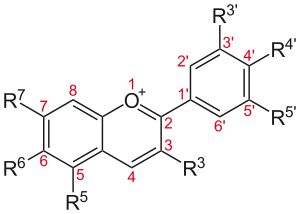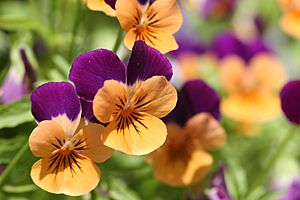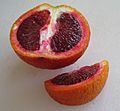Anthocyanin facts for kids
Anthocyanin is a special chemical compound found in plants. It's what gives many fruits, flowers, and vegetables their beautiful red, purple, and blue colors. Think of a bright red apple, a deep purple grape, or a colorful pansy – anthocyanins are often the reason for those shades! For example, red cabbage gets its color from anthocyanins.
Contents
What Do Anthocyanins Do?

Anthocyanins play several important roles in plants. They are like nature's own colorful helpers!
Attracting Pollinators and Seed Spreaders
In flowers, the bright red and purple colors of anthocyanins help to attract pollinators. These are animals like bees and butterflies that help plants make seeds.
In fruits, the colorful skins also grab the attention of animals. When animals eat the fruits, they often help to spread the seeds to new places. This helps new plants to grow.
Protecting Plants from Sunlight
Anthocyanins also act like a "sunscreen" for plants. In parts of the plant that do photosynthesis, like leaves and sometimes stems, anthocyanins protect cells. They do this by soaking up harmful blue-green and ultraviolet light. This protection helps prevent damage to the plant's DNA from strong sunlight.
Other Possible Roles
Scientists have a few other ideas about what anthocyanins might do:
- The red color in leaves might help to hide them from plant-eating animals, called herbivores. Some herbivores cannot see red colors well.
- The color might also signal that the plant tastes bad. This is because anthocyanins often appear with other compounds that make plants unpalatable.
Plants make these pigments using a series of special enzymes. These enzymes are found on the plant's cell membranes.
Images for kids
-
The reds and purples of autumn leaves on the European bilberry come from anthocyanins.
-
Red cabbage extract changes color from low pH (left) to high pH (right).
-
P20 blue tomatoes were made using traditional breeding methods.
-
Anthocyanins and carotenoids give blood oranges their unique color.
See also
 In Spanish: Antocianina para niños
In Spanish: Antocianina para niños








